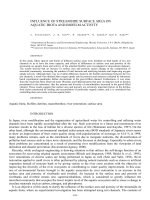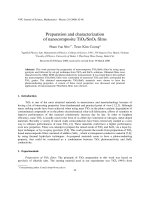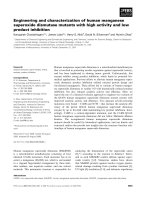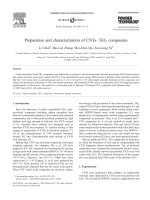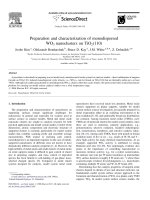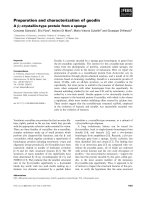- Trang chủ >>
- Khoa Học Tự Nhiên >>
- Vật lý
preparation and characterization of high surface area nanosheet titania with mesoporous structure
Bạn đang xem bản rút gọn của tài liệu. Xem và tải ngay bản đầy đủ của tài liệu tại đây (439.02 KB, 5 trang )
Preparation and characterization of high surface area nanosheet titania
with mesoporous structure
Sorapong Pavasupree
a,b
, Supachai Ngamsinlapasathian
a
,
Yoshikazu Suzuki
a
, Susumu Yoshikawa
a,
⁎
a
Institute of Advanced Energy, Kyoto University, Uji, Kyoto, 611-0011, Japan
b
Department of Materials and Metallurgical Engineering, Faculty of Engineering, Rajamangala University of Technology Thanyaburi,
Klong 6, Pathumthani, 12110, Thailand
Received 6 September 2006; accepted 23 October 2006
Available online 9 November 2006
Abstract
High surface area nanosheet TiO
2
with mesoporous structure were synthesized by hydrothermal method at 130 °C for 12 h. The samples were
characterized by XRD, SEM, TEM, SAED, and BET surface area. The nanosheet structure was slightly curved and approximately 50–100 nm in
width and several nanometers in thickness. The as-synthesized nanosheet TiO
2
had an average pore diameter about 3–4 nm. The BET surface area
and pore volume of the sample are about 642 m
2
/g and 0.774 cm
3
/g, respectively.
© 2006 Published by Elsevier B.V.
Keywords: Nanosheet; Mesoporous; High surface area; TiO
2
1. Introduction
The synthesis and characterization of nanostructured materi-
als (nanotubes, nanorods, nanowires, and nanosheet) have
received considerable attention due to their unique properties
and novel applications [1–4]. Much effort has concent rated on
the important metal oxides such as TiO
2
,SnO
2
,VO
2
, and ZnO
[1–10]. Among them, TiO
2
and TiO
2
-derived materials are of
importance for utilizing solar energy and environmental
purification. TiO
2
has been widely used for various applications
such as a semiconductor in dye-sensitized solar cell, water
treatment materials, catalysts, gas sensors, and so on [11–22].
Functional properties of TiO
2
are influenced by many factors
such as crystallinity, particle size, surface area, and preparation
[11]. In the view point of surface area, nanosheet and nanotubes
(from nanosheet rolling technique) TiO
2
(or titanate) offered
high surface area (about 100–400 m
2
/g) [10,23–31].Inour
previous works, nanofibers TiO
2
were synthesized by hydro-
thermal and post heat-treatments from natural rutile sand,
however, nanofibers TiO
2
had rather low surface area (10–
20 m
2
/g) [32,33].
In this study, high surface area nanosheet TiO
2
with me-
soporous structure (with much higher surface area, 642 m
2
/g)
obtained by hydrothermal at 130 °C for 12 h will be reported.
2. Experimental
2.1. Synthesis
Titanium (IV) butoxide (Aldrich) was mixed with the same
mole of acetyacetone (ACA, Nacalai Tesque, Inc., Japan) to
slowdown the hydrolysis and the condensation reactions [14–16].
Subsequently, 40 ml distilled water was added into the solution,
and the solution was stirred at room temperature for 5 min. After
constant stirring, ammonia aqueous solution 28% (Wako Co.,
Ltd., Japan) 30 ml was added into the solution, then the solution
was put into a Teflon-lined stainless steel autoclave and heated at
130 °C for 12 h with stirring condition. After the autoclave was
naturally cooled to room temperature, the obtained product was
washed with HCl aqueous solution, 2-propanal and distilled water
for several times, followed by drying at 100 °C for 12 h. The
Materials Letters 61 (2007) 2973– 2977
www.elsevier.com/locate/matlet
⁎
Corresponding author. Tel.: +81 774 38 3502; fax: +81 774 38 3508.
E-mail address: (S. Yoshikawa).
0167-577X/$ - see front matter © 2006 Published by Elsevier B.V.
doi:10.1016/j.matlet.2006.10.056
samples were calcined for 4 h at 300–700 °C in air condition
(Fig. 1).
2.2. Characterization
The crystalline structure of the samples was evaluated by X-
ray diffraction (XRD, RIGAKU RINT 2100). The microstruc-
ture of the prepared materials was analyzed by scanning
electron microscopy (SEM, JEOL JSM-6500FE), transmission
electron microscopy (TEM, JEOL JEM-200CX), and selected-
area electron diffraction (SAED ). The Brunauer–Emmett –
Teller (BET) specific surface area was determined by nitrogen
adsorption (BEL Japan, BELSORP-18 Plus).
3. Results and discussion
Fig. 2(a–b) shows the low and high magnification SEM images of
the as-synthesized sample, indicating the flower-like morphology
composed of nanosheets. The flower-like structure had a diameter
about 500 nm to 2 μm(Fig. 3(a)). The nanosheet structure was slightly
curved and approximately 50–100 nm in width and several nanometers
in thickness (Fig. 3(b–c)). The electron diffraction pattern shown in the
inset of Fig. 3(b) supported that the nanosheet was anatase-type TiO
2
,
which corresponded to the XRD results (low crystallinity of anatase
TiO
2
, Fig. 5). In addition, higher magnification TEM (Fig. 3(c)) image
shows nanopores in the flower-like structure.
Fig. 4 gives the nitrogen adsorption isotherm and the pore size
distribution of the as-synthesized nanosheet TiO
2
. The isotherm shows
a typical IUPAC type IV pattern with inflection of nitrogen adsorbed
volume at P/P
0
about 0.45 (type H
2
hysteresis loop), indicating the
existence of mesopores. The pore size distribution of the sample, as
shown in the inset of Fig. 4, showed that the nanosheet TiO
2
with
narrow pore size distribution had an average pore diameter about 3–
4 nm. The BET surface area and pore volume of the as-synthesized
nanosheet TiO
2
are about 642 m
2
/g and 0.774 cm
3
/g, respectively. The
as-synthesized nanosheet TiO
2
(prepared by this method) showed
higher surface area than nanosheet and nanotubes TiO
2
(about 100–
400 m
2
/g) [10,23–31].
Fig. 5 shows the X-ray diffraction pattern of the as-synthesized
nanosheet TiO
2
, and nanosheet TiO
2
calcined for 1 h at 300–700 °C.
The nanosheet TiO
2
calcined for 1 h at 300–500 °C consisted of
anatase TiO
2
structure. The peak intensity of anatase TiO
2
increased as
the calcination temperature was increased. The peaks were rather sharp,
which indicated that the calcined nanosheet TiO
2
had relatively high
crystallinity. The peaks corresponding to rutile TiO
2
appeared at 600 °C
and almost showed rutile TiO
2
structure at 700 °C.
Fig. 6(a–j) shows the SEM, TEM, and SAED images of the
nanosheet TiO
2
calcined for 1 h at 300–700 °C. The nanosheet
structure after calcinations was destroyed and changed to nanorods/
nanoparticles composite with anatase TiO
2
structure at 300–500 °C
(10–15 nm in rods diameter and about 5–10 nm in particles diameter,
Fig. 6(a–f)). The SEM, TEM, and SAED images of the nanosheet TiO
2
calcined at 600 and 700 °C showed almost nanoparticles with a mixture
of anatase and rutile TiO
2
structure (about 10–50 nm in diameter, at
600 °C, Fig. 6(g–h)), and rutile TiO
2
structure (about 40–100 nm in
diameter, at 700 °C, Fig. 6(i–j)).
Fig. 1. Schematic representation of the experimental procedure.
Fig. 2. SEM images of the as-synthesized flower-like nanosheet TiO
2
(a) ×30,000
and (b) ×100,000 magnified.
2974 S. Pavasupree et al. / Materials Letters 61 (2007) 2973–2977
From the above data we can deduce the growth process of the
nanosheet TiO
2
(Fig. 7). At first, amorphous TiO
2
nanoparticles were
prepared by TiBu–ACA in 40 ml H
2
O. There are many aggregations of
TiO
2
nanoparticles (after added ammonia aqueous solution 28%),
which can work as nuclei for TiO
2
growth. The nanosheet TiO
2
grow
under hydrothermal treatment because the nanotubes (from nanosheets
rolling technique) can be synthesized at 110–120 °C for 48–72 h and
dilute base treatment generates thin, curled sheet materials [28–31].
The nanosheet structure after calcinations was destroyed and changed
to nanorods/nanoparticles composite at high temperature [27,30].
4. Conclusions
In summary, high surface area nanosheet TiO
2
with
mesoporous structure were synthesized by hydrothermal
method at 130 °C for 12 h. The nanosheet structure was
slightly curved and approximately 50–100 nm in width and
several nanometers in thickness. The as-synthesized nanosheet
TiO
2
had an average pore diameter about 3–4 nm. The BET
Fig. 3. (a–c) TEM and (inset of (b)) SAED images of the as-synthesized
nanosheet TiO
2
.
Fig. 4. Nitrogen adsorption isotherm pattern of the as-synthesized nanosheet
TiO
2
(BET surface is 642 m
2
/g), and the pore size distribution of the sample with
pore diameter about 3–4 nm (inset).
Fig. 5. X-ray diffraction pattern of the as-synthesized nanosheet TiO
2
and
nanosheet TiO
2
calcined for 1 h at 300–700 °C.
2975S. Pavasupree et al. / Materials Letters 61 (2007) 2973–2977
Fig. 6. SEM, TEM, and SAED images of the nanosheet TiO
2
calcined for 1 h at 300–700 °C.
2976 S. Pavasupree et al. / Materials Letters 61 (2007) 2973–2977
surface area and pore volume of the sample are about 642 m
2
/g
and 0.774 cm
3
/g, respectively. The nanosheet structure after
calcinations was changed into nanorods/nanoparticles compos-
ite with anatase TiO
2
structure at 300–500 °C (10–15 nm in
rods diameter and about 5–10 nm in particles diameter).
Acknowledgements
The authors would like to express their gratitude to Prof. S.
Isoda and Prof. H. Kurata, Institute for Chemical Research,
Kyoto University for the use of TEM apparatus and to Prof. T.
Yoko, Institute for Chemical Research, Kyoto University for the
use of XRD equipment. This work was supported by grant -in-
aids from the Ministry of Education, Science Sports, and
Culture of Japan under the 21 COE program, the Nanotechnol-
ogy Support Project, and from NEDO under high-performance
dye-sensitized solar cell project.
References
[1] C.N.R. Rao, M. Nath, Dalton Trans. 1 (2003) 1.
[2] G.R. Patzke, F. Krumeich, R. Nesper, Angew. Chem. Int. Ed. 41 (2002)
2446.
[3] M. Huang, S. Mao, H. Feick, H. Yan, Y. Wu, H. Kind, E. Weber, R. Russo,
P. Yang, Science 292 (2001) 1897.
[4] Z.W. Pan, Z.R. Dai, Z.L. Wang, Science 291 (2001) 1947.
[5] L. Miao, S. Tanemura, S. Toh, K. Kaneko, M. Tanemura, Appl. Surf. Sci.
238 (2004) 175.
[6] C. Xu, Y. Zhan, K. Hong, G. Wang, Solid State Commun. 126 (2003) 545.
[7] B. Cheng, J.M. Russell, W. Shi, L. Zhang, E.T. Samulski, J. Am. Chem.
Soc. 126 (2004) 5972.
[8] S. Pavasupree, Y. Suzuki, A. Kitiyanan, S. Pivsa-Art, S. Yoshikawa, J. Solid
State Chem. 178 (2005) 2152.
[9] S. Pavasupree, Y. Suzuki, S. Pivsa-Art, S. Yoshikawa, Sci. Technol. Adv.
Mater. 6 (2005) 224.
[10] T. Sasaki, S. Nakano, S. Yamauchi, M. Watanabe, Chem. Mater. 9 (1997)
602.
[11] O. Carp, C.L. Huisman, A. Reller, Prog. Solid State Chem. 32 (2004) 33.
[12] M. Grätzel, Nature 414 (2001) 338.
[13] A. Fujishima, T.N. Rao, D.A. Tryk, J. Photochem. Photobiol. C:
Photochem. Rev. 1 (2000) 1.
[14] M. Adachi, Y. Murata, M. Harada, S. Yoshikawa, Chem. Lett. 8 (2000)
942.
[15] M. Adachi, I. Okada, S. Ngamsinlapasathian, Y. Murata, S. Yoshikawa,
Electrochemistry 70 (2002) 449.
[16] M. Adachi, Y. Murata, I. Okada, S. Yoshikawa, J. Electrochem. Soc. 150
(8) (2003) G488.
[17] S. Ngamsinlapasathian, T. Sreethawong, Y. Suzuki, S. Yoshikawa, Sol.
Energy Mater. Sol. Cells 86 (2005) 269.
[18] S. Pavasupree, Y. Suzuki, S. Pivsa-Art, S. Yoshikawa, Ceram. Int. 31
(2005) 959.
[19] S. Pavasupree, Y. Suzuki, S. Pivsa-Art, S. Yoshikawa, J. Solid State Chem.
178 (2005) 128.
[20] T. Sreethawong, Y. Suzuki, S. Yoshikawa, J. Solid State Chem. 178 (2005)
329.
[21] A. Kitiyanan, S. Ngamsinlapasathian, S. Pavasupree, S. Yoshikawa, J. Solid
State Chem. 178 (2005) 1044.
[22] S. Sakulkhaemaruethai, S. Pavasupree, Y. Suzuki, S. Yoshikawa, Mater.
Lett. 59 (2005) 2965.
[23] T. Kasuga, M. Hiramatsu, A. Hoson, T. Sekino, K. Niihara, Langmuir 14
(1998) 3160.
[24] D.S. Seo, J.K. Lee, H.J. Kim, Cryst. Growth 229 (2001) 428.
[25] Z.Y. Yuan, W. Zhou, B.L. Su, Chem. Commun. 11 (2002) 1202.
[26] Q. Zhang, L. Gao, J. Sun, S. Zheng, Chem. Lett. 31 (2002) 226.
[27] C C. Tsai, H. Teng, Chem. Mater. 16 (2004) 4352.
[28] Y F. Chen, C Y. Lee, M Y. Yeng, H T. Chiu, Mater. Chem. Phys. 81
(2003) 39.
[29] Y. Suzuki, S. Yoshikawa, J. Mater. Res. 19 (2004) 982.
[30] R. Yoshida, Y. Suzuki, S. Yoshikawa, Mater. Chem. Phys. 91 (2005) 409.
[31] R. Yoshida, Y. Suzuki, S. Yoshikawa, J. Solid State Chem. 178 (2005)
2179.
[32] Y. Suzuki, S. Pavasupree, S. Yoshikawa, R. Kawahata, J. Mater. Res. 20
(2005) 1063.
[33] S. Pavasupree, Y. Suzuki, S. Yoshikawa, R. Kawahata, J. Solid State
Chem. 178 (2005) 3110.
Fig. 7. Schematic representation of the growth diagram of nanosheet and nanorods/nanoparticles TiO
2
.
2977S. Pavasupree et al. / Materials Letters 61 (2007) 2973–2977
